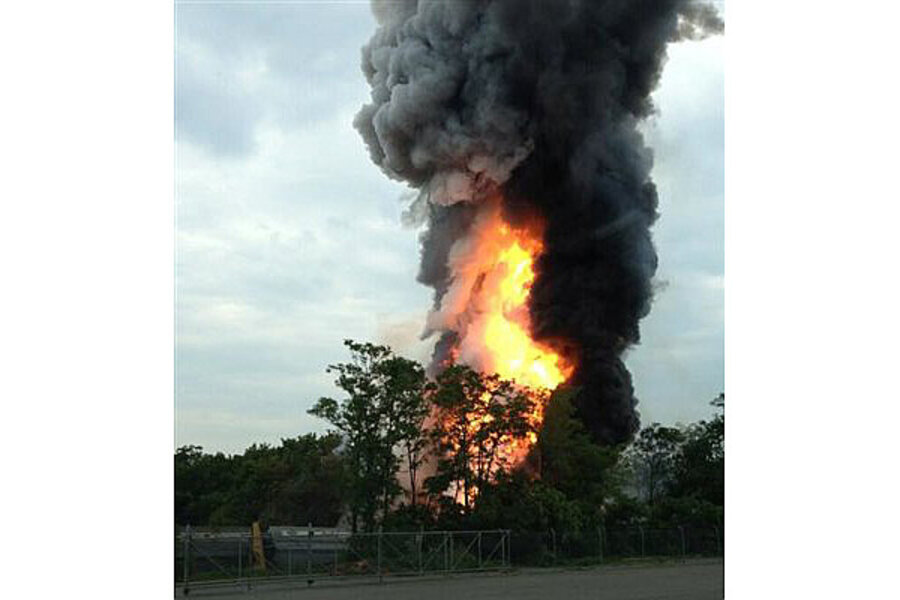Train derailment: What's in the massive smoke plume?
Loading...
| ROSEDALE, Maryland
A CSX freight train crashed into a trash truck, derailed, and caught fire Tuesday in a Baltimore suburb, setting off an explosion that rattled homes at least a half-mile (800 meters) away and sent a plume of smoke into the air that could be seen for miles.
In the third serious train derailment this month, the dozen or so rail cars, at least one carrying hazardous material, went off the tracks at about 2 p.m. in Rosedale, a suburb east of Baltimore. A hazardous materials team responded, but Baltimore County Executive Kevin Kamenetz said at a news conference that no toxic inhalants were being released. Officials did not order an evacuation.
By nightfall, the hazmat team had left, meaning there was no more danger posed from the chemicals in the rail car, said Baltimore County police Capt. Bruce Schultz.
The truck driver, 50-year-old John J. Alban Jr., was in serious condition Tuesday night, a hospital spokeswoman said. Two CSX workers aboard weren't hurt.
Dale Walston said he lives about a half-mile away and that he thought he could smell chemicals.
"It shook my house pretty violently and knocked things off the shelves," he said in an email to The Associated Press.
Even hours after the blast, the thick plume of black smoke could be seen for miles and had drifted and covered the eastern part of Baltimore. Later, the smoke that was left had lightened considerably, changing from black to gray, though the fire wasn't yet extinguished as of 9 p.m.
CSX spokesman Gary Sease said in an email that one of the cars was carrying sodium chlorate, which the Department of Transportation classifies as a hazardous material. However, Baltimore County Fire Chief John Hohman said the chemical was not in any of the cars that were still burning into the evening. The bleaching agent is used in making paper.
Two warehouses were heavily damaged by the explosion and other buildings suffered some damage, but none collapsed.
The National Transportation Safety Board and the Federal Railroad Administration were sending teams to investigate Tuesday's crash of the 45-car freight train en route from Selkirk, New York, to Waycross, Georgia.
Late Tuesday evening, Robert Sumwalt of the NTSB said the accident occurred at a private crossing where the only marking was a stop sign. He said it wasn't clear why the truck was crossing the tracks or whether it was authorized to be there.
Photos showed at least a dozen rail cars off the tracks, including at least one tanker car. Sease said four of the cars believed derailed carried terephthalic acid, which is used in the production of plastics and polyester, among other things. He said it is not listed as a hazardous material.
Sumwalt said it was the chemical that exploded as a result of the derailment.
It was the third serious derailment this month. On May 17, more than 70 people were injured when a commuter train went off the tracks in Bridgeport, Connecticut, and was then struck by another train. In Rockview, Missouri, on Saturday, a cargo train crash injured seven people and destroyed a highway overpass, which could take a year to repair.
Despite the high-profile railroad accidents, the overall number of such crashes has been declining industry wide. Last year was the safest year on record for the railroad industry, according to the railroad administration.
Associated Press writers Kasey Jones in Baltimore, David Dishneau in Hagerstown, Josh Funk in Omaha, Nebraska, and Joan Lowy in Washington, D.C., contributed to this report.







